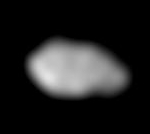https://en.wikipedia.org/wiki/Metis_(moon) wrote:
<<Metis (Greek: Μήτις), also known as Jupiter XVI, is the innermost moon of Jupiter. It was discovered in 1979 in images taken by Voyager 1, and was named in 1983 after Metis, a Titaness who was the first wife of Zeus. Although the Juno orbiter, which arrived at Jupiter in 2016, has a camera called JunoCam, it is almost entirely focused on observations of Jupiter itself. However, if all goes well it should be able to capture some limited images of the innermost moons Metis and Adrastea.
Metis is one of the two moons known to orbit Jupiter [7 h, 4.5 min] in less than the length of Jupiter's day [Sidereal rotation period: 9 h 55 m 30 s], the other being Adrastea [7 h, 9.5 min]. Metis is the fastest-moving moon; it orbits Jupiter at 31.5 km/s [vs. ~0.37 km/s for Neso]. Metis orbits within the main ring of Jupiter, and is thought to be a major contributor of material to the rings. Metis's orbit lies within the fluid Roche limit; however, because it has not broken up, it must lie outside its rigid Roche limit.
The surface of Metis is heavily cratered, dark, and appears to be reddish in color. There is a substantial asymmetry between leading and trailing hemispheres: the leading hemisphere is 1.3 times brighter than the trailing one. The asymmetry is probably caused by the higher velocity and frequency of impacts on the leading hemisphere, which excavate a bright material (presumably ice) from its interior.
Metis is the innermost of Jupiter's four small inner moons. It orbits Jupiter at a distance of ~128,000 km (1.79 Jupiter radii) within Jupiter's main ring. Metis's orbit has very small eccentricity (~0.0002) and inclination (~ 0.06°) relative to the equator of Jupiter. Metis lies inside Jupiter's synchronous orbit radius (as does Adrastea), and as a result, tidal forces slowly cause its orbit to decay. If its density is similar to Amalthea's, Metis's orbit lies within the fluid Roche limit; however, because it has not broken up, it must lie outside its rigid Roche limit.
Metis's orbit lies ~1000 km within the main ring of Jupiter. It orbits within a ~500 km wide "gap" or "notch" in the ring. The gap is clearly somehow related to the moon but the origin of this connection has not been established. Metis supplies a significant part of the main ring's dust. This material appears to consist primarily of material that is ejected from the surfaces of Jupiter's four small inner satellites by meteorite impacts.>>
